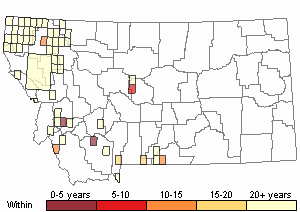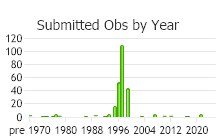View in other NatureServe Network Field Guides
NatureServe
Montana
Utah
Wyoming
Idaho
Wisconsin
British Columbia
South Carolina
Yukon
California
New York
Copper-wire Moss - Pohlia nutans
Other Names:
Common Nodding Moss
General Description
"Nutans" means “drooping,” in reference to the pendent capsule (Crum 1981). The common name, “Copper-Wire Moss,” refers to the characteristic color of the setae (Vitt).
Plants: Acrocarpus. Growing in tufts, yellow-green to green, dull or barely glossy (Crum 1981). Stems 0.5-3.5(-10) cm tall (FNA 2014), reddish, mostly unbranched (Crum 1981).
Leaves: Upright or spreading a little(FNA 2014), with slight winding around the stem possible when dry, 2-3 (seldom 4) mm in length, longer and more dense near the top, lance-acuminate (Crum 1981) to ovate-lanceolate (FNA 2014), barely if at all decurrent; margins toothed distally, sometimes curved back and downwards when dry (Lawton 1971); costa well-developed (Crum 1981), ending just below, at, or rarely shortly extending beyond the apex. Leaves of perichaetium long-lanceolate, those of perigonium ovate-lanceolate (FNA 2014).
Leaf Cells: Incrassate, thin or narrowly rhombic (Crum 1981); distal medial cells 6-sided or rhombic (FNA 2014), the basal cells rectangular and a little shorter than the distal ones (Crum 1981).
Phenology
Capsules ripen April-June (FNA 2014).
Diagnostic Characteristics
P. nutans is similar to P. cruda structurally and in size. P. nutans, however, distal cells with moderately thick walls (Crum 1981) rather than thin, has leaves slenderly lanceolate rather than ovate-lanceolate, and is smaller and dull in comparison to the yellow-green/gold iridescence of P. cruda (Vitt 1988; FNA 2014).
Range Comments
Greenland; Canada: AB, BC, MB, NB, NL, NT, NS, NU, ON, PE, QC, SK, YT; USA: AL, AK, AZ, AR, CA, CO, CT, DE, DC, FL, GA, ID, IL, IN, IA, KS, KY, LA, ME, MD, MA, MI, MN, MS, MO, MT, NE, NV, NH, NJ, NM, NY, NC, ND, OH, OK, OR, PA, RI, SC, SD, TN, TX, UT, VT, VA, WA, WI, WY; Mexico (Nuevo León); Eurasia; Africa; Australia (FNA 2014).
Observations in Montana Natural Heritage Program Database
Number of Observations: 320
(Click on the following maps and charts to see full sized version)
Map Help and Descriptions
Relative Density

Recency



 (Observations spanning multiple months or years are excluded from time charts)
(Observations spanning multiple months or years are excluded from time charts)
Habitat
On rotten stumps and logs, occasionally on burned wood, on soil at base of trees, in bank fissures, from densely-canopied to more open areas, disturbed areas, in Sphagnum mounds(Crum 1981, FNA 2014). Vitt (1988) specifically notes that it frequently occurs in forests of the north and mountains, often to be found on “just about every log in white spruce-pine forests of the Rockies and Interior British Columbia areas.”
A. J. Shaw’s P. sphagnicola (1982), that grows in Sphagnum, is treated here as P. nutans (FNA 2014).
Reproductive Characteristics
Autoicous; seldom dioicous. Setae 14-33 (seldom up to 50) mm in length, flexuous, yellow-, red- or orange-brown. Capsules oriented 80-100 degrees from vertical, orange or brown with orange tints; capsule neck making up about 1/3 to 1/2 of the capsule’s length, sometimes greatly contracted when dry; peristome teeth with fine papillae; exostome teeth yellow or orange-brown; endostome hyaline or seldom brown with orange tints (FNA 2014), with wide keels open or perforate, and 2 or 3 short to long cilia with knobbed fine tips inbetween the teeth (Crum 1981, FNA 2014).
Usually no specialized vegetative reproduction occurs (FNA 2014).
Stewardship Responsibility
References
- Literature Cited AboveLegend:
 View Online Publication
View Online Publication Crum, H.A. and L.E. Anderson. 1981. Mosses of Eastern North America. 2 volumes. Columbia University Press, New York. 1328 pp.
Crum, H.A. and L.E. Anderson. 1981. Mosses of Eastern North America. 2 volumes. Columbia University Press, New York. 1328 pp. Elliott, J.C. and A.K. Pipp. 2018. A Checklist of Montana Mosses (1880-2018). Updated 3 January, 2020. Montana Natural Heritage Program, Helena, Montana. 73 pp.
Elliott, J.C. and A.K. Pipp. 2018. A Checklist of Montana Mosses (1880-2018). Updated 3 January, 2020. Montana Natural Heritage Program, Helena, Montana. 73 pp. Flora of North America Editorial Committee, eds. 2014. Flora of North America North of Mexico. Volume 28. Bryophytes: Mosses, Part 2. Oxford University Press, Inc., NY. xxi + 702 pp.
Flora of North America Editorial Committee, eds. 2014. Flora of North America North of Mexico. Volume 28. Bryophytes: Mosses, Part 2. Oxford University Press, Inc., NY. xxi + 702 pp. Lawton, E. 1971. Moss Flora of the Pacific Northwest. Hattori Botanical Laboratory. Japan: Yamabuki-cho, Shinjuku-ku, Tokyo. 362 pages plus appendices.
Lawton, E. 1971. Moss Flora of the Pacific Northwest. Hattori Botanical Laboratory. Japan: Yamabuki-cho, Shinjuku-ku, Tokyo. 362 pages plus appendices. Shaw, J. 1982. Pohlia Hedw. (Musci) in North and Central America and the West Indies. Contributions from the University of Michigan Herbarium, 15: 219-295.
Shaw, J. 1982. Pohlia Hedw. (Musci) in North and Central America and the West Indies. Contributions from the University of Michigan Herbarium, 15: 219-295. Vitt, D. J. Marsh, and R. Bovey. 1988. Mosses, Lichens & Ferns of Northwest North America. Seattle, WA: University of Washington Press. 296 p.
Vitt, D. J. Marsh, and R. Bovey. 1988. Mosses, Lichens & Ferns of Northwest North America. Seattle, WA: University of Washington Press. 296 p.
- Additional ReferencesLegend:
 View Online Publication
View Online Publication
Do you know of a citation we're missing? Elliot, J. C. 1993. Second checklist of Montana mosses. Unpublished report. U.S. Forest Service, Region 1. Missoula, MT. 45 pp.
Elliot, J. C. 1993. Second checklist of Montana mosses. Unpublished report. U.S. Forest Service, Region 1. Missoula, MT. 45 pp. Lawton, E. 1971. Keys for the Identification of the Mosses on the Pacific Northwest. Reprinted from 'Moss Flora of the Pacific Northwest'. Published as Supplement No. 2 of the Journal of the Hattori Botanical Laboratory. Nichinan, Miyazaki, Japan. 66 pp.
Lawton, E. 1971. Keys for the Identification of the Mosses on the Pacific Northwest. Reprinted from 'Moss Flora of the Pacific Northwest'. Published as Supplement No. 2 of the Journal of the Hattori Botanical Laboratory. Nichinan, Miyazaki, Japan. 66 pp.
- Web Search Engines for Articles on "Copper-wire Moss"





